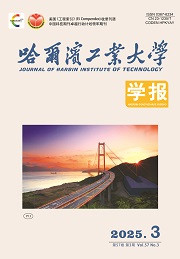| 引用本文: | 白玉磊,杨凯,韩强,于辉,张玉峰,孟庆利.高延性FRP加固RC矩形柱抗震性能[J].哈尔滨工业大学学报,2022,54(4):82.DOI:10.11918/202109018 |
| BAI Yulei,YANG Kai,HAN Qiang,YU Hui,ZHANG Yufeng,MENG Qingli.Seismic behavior of RC square columns strengthened with large-rupture-strain FRP[J].Journal of Harbin Institute of Technology,2022,54(4):82.DOI:10.11918/202109018 |
|
| |
|
|
| 本文已被:浏览 1180次 下载 955次 |

码上扫一扫! |
|
|
| 高延性FRP加固RC矩形柱抗震性能 |
|
白玉磊1,杨凯1,韩强1,于辉2,张玉峰1,孟庆利3
|
|
(1.城市与工程安全减灾教育部重点实验室(北京工业大学),北京 100124; 2.河北工程大学 土木工程学院,河北 邯郸 056004; 3.西南科技大学 土木工程与建筑学院,四川 绵阳 621000)
|
|
| 摘要: |
| 为了研究地震作用下高延性纤维增强复合材料(large-rupture-strain fiber reinforced polymer,LRS FRP)加固非延性钢筋混凝土(reinforced concrete,RC)方柱的抗震性能,对7个FRP加固RC方柱进行了拟静力试验。试验试件包括1根对比柱,1根碳纤维(carbon FRP,CFRP)加固柱和5根高延性(LRS)FRP加固柱。通过分析不同试件的破坏形态、抗震性能参数、FRP应变,研究了FRP种类和加固层数对其破坏形态和抗震性能的影响。试验结果表明:在轴压荷载与水平往复荷载作用下,未加固柱的破坏形式为塑性铰区混凝土保护层发生剥落并被压碎,纵筋发生严重屈曲,而FRP加固柱均未产生混凝土的剥落,FRP布也未断裂,表明FRP加固改变了非延性柱的破坏形态;与未加固柱相比,FRP加固显著提高了RC柱的延性和耗能能力,但对其最大水平承载力的提高程度较小;FRP加固减小了纵筋和箍筋的应变,抑制了纵筋屈曲现象;相比于CFRP加固柱,LRS FRP的高延性优势在试验中并不明显,主要原因是本论文墩柱的轴压比较小和长细比较大, 塑性铰区FRP约束混凝土的受压区面积较小。基于在OpenSees软件平台中二次开发的高延性FRP约束混凝土应力应变模型对试验结果进行模拟,模拟曲线与试验曲线较为吻合,验证了该模型在FRP加固墩柱抗震分析中的准确性和可靠性。 |
| 关键词: FRP加固 拟静力试验 高延性FRP 抗震性能 钢筋屈曲 |
| DOI:10.11918/202109018 |
| 分类号:TU375 |
| 文献标识码:A |
| 基金项目:北京市自然科学基金(8212003); 国家自然科学基金(9,7); 北京市科技新星(Z201100006820095) |
|
| Seismic behavior of RC square columns strengthened with large-rupture-strain FRP |
|
BAI Yulei1,YANG Kai1,HAN Qiang1,YU Hui2,ZHANG Yufeng1,MENG Qingli3
|
|
(1.Key Lab of Urban Security and Disaster Engineering (Beijing University of Technology), Ministry of Education, Beijing 100124, China; 2.School of Civil Engineering, Hebei University of Engineering, Handan 056004, Hebei, China; 3.School of Civil Engineering and Architecture, Southwest University of Science and Technology, Mianyang 621000, Sichuan, China)
|
| Abstract: |
| In order to evaluate the seismic performance of large-rupture-strain fiber reinforced polymer (LRS FRP) confined non-ductile reinforced concrete (RC) square columns under earthquake action, quasi-static experiments were carried out on seven FRP-strengthened RC square columns, including a reference column, a carbon FRP (CFRP)-strengthened column, and five LRS FRP-strengthened columns. The failure modes, seismic performance parameters, and FRP strain of specimens were analyzed, and the effects of FRP types and fiber thicknesses on the failure modes and seismic performance of different specimens were studied. Results show that under axial load and cyclic lateral load, the cover concrete of the reference column in the plastic hinge zone was peeled off and crushed, and the longitudinal bars were severely buckled, while the FRP-strengthened columns did not experience concrete spalling or FRP rupture, indicating that FRP reinforcement changes the failure mode of non-ductile column. Compared with the reference column, the application of FRP significantly improved the ductility and energy dissipation capacity of the RC columns, while the increase in the maximum horizontal bearing capacity was marginal. FRP reinforcement decreased the strain of the longitudinal bars and stirrups, and prevented the buckling of the longitudinal bars. Compared with the CFRP-strengthened column, the large-rupture-strain advantage of LRS FRP was not obvious. The main reason was that the axial load ratio was low and the slenderness ratio was high in this study, so that the compressive area of the FRP confined concrete in the plastic hinge zone was small. Based on the stress-strain model of LRS FRP-confined concrete developed on OpenSees software platform, the experimental results were simulated, and the simulated curve agreed well with the experimental curve, which verified the accuracy and reliability of the model in the seismic analysis of FRP reinforced columns. |
| Key words: FRP strengthening quasi-static experiment large-rupture-strain fiber reinforced polymer (LRS FRP) seismic performance steel bar buckling |
|
|
|
|







